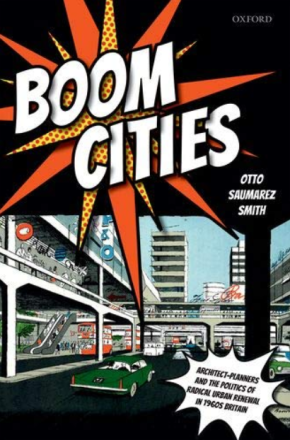Boom Cities: architect-planners and the politics of urban renewal in 1960s Britain

|
| Boom Cities: architect-planners and the politics of urban renewal in 1960s Britain, Otto Saumarez Smith, Oxford University Press, 2019, 198 pages, 31 black & white illustrations. |
Otto Saumarez Smith, an assistant professor at the University of Warwick, recognises himself ‘as part of a generation born after the glory days of the welfare state which looks back on the physical remains of this vanished era with nostalgia for a lost idealism’. Boom Cities deals with a subject that has received an overwhelmingly negative press: the redevelopment of city centres in the 1960s, from the more balanced and nuanced perspective of a young scholar who was not there at the time.
Saumarez Smith identifies 1963 (the year of publication of Traffic in Towns, Wilfred Burns’ plan for Newcastle and Peter Hall’s vision of the London region in 2000) as a high point of city-centre redevelopment. It was a period of economic prosperity, optimism and an assumption that motor traffic could grow almost without limit. These were views shared across the political parties. Consultancies and local authorities employed the dual-qualified architect-planners who would reshape cities to reflect the 60s zeitgeist. Konrad Smigielski’s 1964 Leicester Traffic Plan rode this wave of positive energy. The plan, like Smigielski’s work in general, had much in it that was good, including an emphasis on public transport. But, with elements like a monorail system, it proved over-ambitious.
Blackburn’s was one of the earliest and most radical redevelopment schemes, promoted by a public private partnership. It covered six hectares of the city centre, separating traffic and pedestrians. The result was praised at the time by critics such as Ian Nairn, and Saumarez Smith finds Blackburn still worthy of respect. Graeme Shankland’s plans for Liverpool and Bolton followed; his unbuilt plan for Hook new town provided a model. The excitement generated by Shankland’s radical plan for Liverpool was not followed through and left large areas of dereliction. The plan for Bolton was more successful. The aristocratic Lionel Brett had a more incremental approach than Shankland in his plans for Hatfield new town and Portsmouth, and in his 1966 conservation study for York. By 1970 Brett had moved to advocating a restrained approach to redevelopment before his career took off in a different direction.
Tracing the overall trajectory of city-centre redevelopment, Saumarez Smith quotes Richard Crossman, minister in the 1964 Labour government, admiring the rigorous geometry of Cumbernauld while privately suspecting that most people would prefer the kind of living environment offered by Welwyn Garden City. Crossman was also concerned about the contrast between ambitious drawings and poor quality in the corresponding built schemes. Saumarez Smith identifies a mismatch between schemes designed on the basis of an assumption of future affluence and the reality of cities like Stoke-on-Trent which were moving towards a post-industrial state. He ends the book with a useful plea for a holistic view of the post-1945 legacy, including ‘the shopping centre, the roads and the underpasses’. The story, he concludes, has ‘its share of both idealism and crassness’ and ‘doesn’t fit neatly into a polemic’.
Older readers may find that the author’s portrayal of ‘architect-planners’ as urban power brokers does not quite ring true: in the reviewer’s memory these professionals were sometimes ruminative types who developed an interest in the then niche field of conservation. Academic publishing is clearly challenging but it is a pity that the price of the book may deter many who would find Boom Cities interesting and enjoyable. This is a brilliantly researched and very readable book.
This article originally appeared as ‘Redevelopers and ruminants’ in IHBC's Context 161 (Page 61), published by The Institute of Historic Building Conservation in September 2019. It was written by Michael Taylor, editorial coordinator for Context.
--Institute of Historic Building Conservation
Related articles on Designing Buildings Wiki
- Adam Curtis - The Great British Housing Disaster.
- Ballymun mass housing and regeneration.
- Barlow report.
- British post-war mass housing.
- Brutalism.
- Conservation.
- Garden cities.
- Housing contribution to regeneration.
- IHBC articles.
- Modernist Estates - Europe: the buildings and the people who live in them today.
- Municipal Dreams: the rise and fall of council housing.
- New Town Development Corporation.
- New towns.
- The Institute of Historic Building Conservation.
IHBC NewsBlog
Images from inside a Grade II listed hotel show the scale of its collapse
The Corbett Arms in Tywyn has fallen into serious disrepair.
Old Sarum fire in listed (& disputed) WW1 Hangar - Wiltshire Council has sought legal advice after fire engulfed a listed First World War hangar that was embroiled in a lengthy planning dispute.
UK Antarctic Heritage Trust launches ‘Virtual Visit’ website area
The Trust calls on people to 'Immerse yourself in our heritage – Making Antarctica Accessible'
Southend Council pledge to force Kursaal owners to maintain building
The Council has pledged to use ‘every tool in the toolbox’ if urgent repairs are not carried out.
HE’s Research Magazine publishes a major study of the heritage of England’s suburbs
The article traces the long evolution of an internal programme to research 200 years of suburban growth
IHBC Context 183 Wellbeing and Heritage published
The issue explores issues at the intersection of heritage and wellbeing.
SAVE celebrates 50 years of campaigning 1975-2025
SAVE Britain’s Heritage has announced events across the country to celebrate bringing new life to remarkable buildings.
IHBC Annual School 2025 - Shrewsbury 12-14 June
Themed Heritage in Context – Value: Plan: Change, join in-person or online.
200th Anniversary Celebration of the Modern Railway Planned
The Stockton & Darlington Railway opened on September 27, 1825.
Competence Framework Launched for Sustainability in the Built Environment
The Construction Industry Council (CIC) and the Edge have jointly published the framework.














